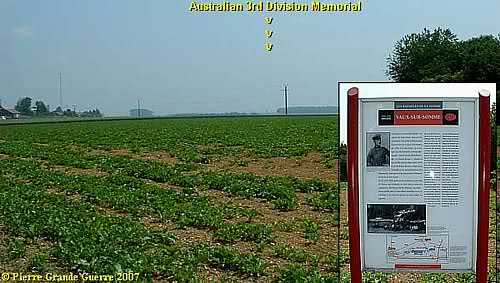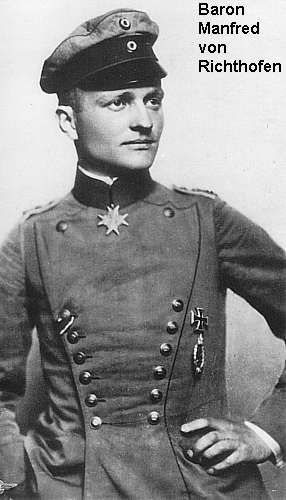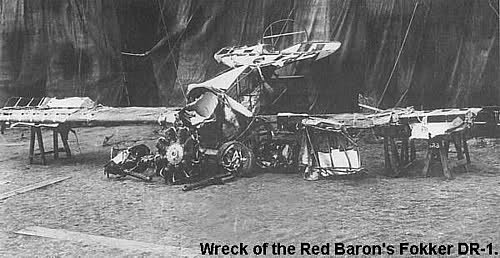Von Richthofen's Laatste Noodlanding
duda-wsm • 29 March 2019
DUTCH Page - Pierre's Column d.d 21-04-2008

Zelden was ik zo onder de indruk van een aardappelveld dan toen ik de plek bezocht, waar op 21 april 1918, vandaag negentig jaar geleden, de Rode Baron zwaar gewond met zijn vliegtuig een wanhopige noodlanding maakte.
Rittmeister Manfred Freiherr Von Richthofen (1892-1918) was niet zomaar een Duitse piloot die neergeschoten was, maar de Duitse Aas der Azen, die neerstortte in dit aardappelveld nabij Vaux sur Somme. Op het moment dat Von Richthofen met veel moeite in zijn nauwelijks beschadigde vliegtuig op de grond was geland, sprak hij nog snel voor zijn dood nog zijn enige en laatste woord: “Kaputt!”.
Tot aan zijn dood had de piloot sinds het begin van zijn carrière in september 1916 als vliegenier bij de "Luftstreitkräfte" maar liefst 80 overwinningen in de lucht behaald op geallieerde vliegtuigen. In het korte leven, dat een gevechtspiloot beschoren was tijdens de Grote Oorlog (enkele tientallen vlieguren), promoveerde men al ogenschijnlijk snel tot de eretitel “Aas” bij vijf overwinningen.
“Le Diable Rouge”, zoals de Fransen Von Richthofen noemden, begon zijn carrière nogal saai in 1914 als ruiter bij de Uhlanen aan het Oostfront. In 1915 wist hij een overplaatsing gedaan te krijgen naar de Luftstreitkräfte. Hij begon als waarnemer bij de postduivenafdeling van het eerste Duitse bommenwerpersquadron in Oostende.
In 1916 pas kreeg Von Richthofen zijn kans een opleiding tot “Flugzeugführer” succesvol af te ronden. De “Red Baron”, zoals de Britten hem noemden, voerde, als lid van “Jagdstaffel 2”, zijn eerste succesvolle gevechtsactie uit in een Albatros DR-III tweedekkervliegtuig op 17 september 1916 boven Cambrai. Dat Von Richthofen een talent had voor luchtgevechten bleek al twee maanden later, op 23 november 1916, toen de Rode Baron de legendarische Britse Aas, Major Lanoe
Hawker VC, wist uit te schakelen boven le Sars. Hawker was zijn elfde slachtoffer. Toen Von Richthofen zijn 18de slachtoffer maakte en ernstig gewond was geraakt aan zijn hoofd, ontving hij voor zijn overwinningen de hoogste Pruisische dapperheidonderscheiding, “Pour le Merite”.

In januari 1917 kreeg Von Richthofen het bevel over “Jagdstaffel 11”, dat al snel de bijnaam kreeg van Von Richthofen’s “Fliegender Zirkus”, omdat de leden van dit elite squadron hun vliegtuigen in nogal bizarre kleuren lieten schilderen. Het vliegtuig, waarin Von Richthofen neerstortte, was een in uitdagend rood geschilderde Fokker DR-1 driedekkervliegtuig. Uiteraard had de Rode Baron zijn bijnaam dan ook aan zijn rode vliegtuig te danken.
In april 1917 wist Von Richthofen’s “Jagdstaffel 11” de Britten tot wanhoop te brengen. Zelf schoot de Rode Baron in die maand 20 Britse vliegtuigen neer, en zijn vliegende kameraden schoten er ook nog enkele tientallen neer, zodat de Britten dat jaar zelfs al spraken van een “Bloody April”.
Op de dag dat Von Richthofen gedwongen was zijn noodlanding te maken, was hij nog maar net een maand gepromoveerd tot bevelhebber van “Jagdgeschwader 1”, een samenvoeging van vier “Jagdstaffeln”.
Die ochtend op 21 april vertrok Von Richthofen vanaf een vliegveld nabij Cappy sur Somme voor een luchtgevecht met een groep Britse R.E.8-vliegtuigen en Sopwith Camels onder bevel van de Canadese piloot, Roy Brown, die al 11 overwinningen op zijn naam had staan. Tijdens deze “dogfight” werd Von Richthofen door een kogel in zijn longen en hart geraakt. Toch wist hij nog, zo goed en zo kwaad als dat ging, zijn beschadigde vliegtuig in dit aardappelveld te landen, dat toen tot aan de horizon en verder een kapotgeschoten woestenij was in de hel van het Westelijk Front.
Brown eiste de eer op, dat hij die dag Von Richthofen had neergeschoten. Maar door de hoek, waaronder de fatale kogel Von Richthofen’s borst was binnengedrongen, bleek later toch, dat de claim van de Australische soldaten van de 14de Artillerie Brigade terecht was. Het rode vliegtuig was, zoals de Gunner, George Ridgeway, getuigde, vanaf de grond neergeschoten door Australische “Lewis Machine Guns”.
De Rode Baron had nog nauwelijks zijn laatste woord,”Kaputt!”, gesproken, of Australische, souvenirjagende soldaten begonnen zijn Fokker DR-1 verder te strippen tot het echt een wrak was.

De Australiërs vertoonden na afloop toch nog een opmerkelijk staaltje van 19de eeuwse officieren-eer en respect voor hun eervolle vijand. (*) Zij vereerden hun tegenstander met een begrafenis met militaire eer en saluutschoten op de oorlogsbegraafplaats bij Bertangles. (**) ( Zie de video onderaan
!)
Zijn “Jagdgeschwader” vernam definitief van zijn sneuvelen via een boodschap uit de lucht, afgeworpen door de Britten boven hun vliegveld bij Cappy:
“To the German Flying Corps. Rittmeister Baron Manfred von Richthofen was killed in aerial combat on April 21st 1918. He was buried with full military honours.”
De crash site van de Rode Baron mag voor u misschien toch een simpel aardappelveldje blijven. Voor mij is het de enige tastbare herinnering aan een toch opmerkelijke geschiedenis.
Pierre
Zie verder deze film van de begrafenis van de Rode Baron:
Zie verder deze film van de begrafenis van de Rode Baron:
Tip! Meer foto’s zien? Meer weten over de Rode Baron? Of een film bekijken van het opstijgen van von Richthofen?
Klik
op
The Red Baron’s Crash Site
.
(*) Een verschijnsel overigens, dat tijdens de Grote Oorlog soms ook bij de Duitsers opdook, zoals de eervolle behandeling door de Duitsers van de krijgsgevangene, Franse Kapitein Raynal, de held van Fort Vaux
.
(**) Daar ligt de Rode Baron niet meer. Zie onderaan The Red Baron’s Crash Site
.

Inleiding: Franz Von Papen & Werner Horn; schaker en pion Onlangs stuitte ik in een oud boek (1) van 1919 op een opmerkelijk verhaal over een Duitse Luitenant, die in begin februari 1915 een half geslaagde bomaanslag pleegt op een spoorbrug over een grensrivier tussen de Verenigde Staten en Canada. Ook al staat de bekentenis van de dader, Werner Horn, deels in het boek te lezen, de naam van zijn opdrachtgever zal Horn blijven verzwijgen. Na wat verder zoeken vond ik ook de naam van Horn’s opdrachtgever, Franz von Papen, een van de aangeklaagden van het latere Neurenberg Proces in 1946. In een Grote Oorlog als de Eerste Wereldoorlog is Horn’s aanslag op de brug uiteraard slechts een bescheiden wapenfeit. Toch vermoed ik dat dit relatief onbekende verhaal, dat de geschiedenis is ingegaan als de “ Vanceboro International Bridge Bombing ”, nog interessante kanten kent. Het is onder andere een spionageverhaal over hoe in een groter plan een sluwe schaker zijn naïeve pion offert. Beknopte situatieschets Canada en de Verenigde Staten in 1915

This trip we start at the Léomont near Vitrimont and we will with some exceptions concentrate on the Battle of Lorraine of August-September 1914 in the area, called, the “Trouée de Charmes”, the Gap of Charmes. After the Léomont battlefield we continue our explorations to Friscati hill and its Nécropole Nationale. Next we pay a visit to the battlefield of la Tombe to go on to the Château de Lunéville. There we cross the Vezouze to move on southward to the Bayon Nécropole Nationale. At Bayon we cross the Moselle to pass Charmes for the panorama over the battlefield from the Haut du Mont. North-west of Charmes we will visit the British Military Cemetery containing 1918 war victims. From Charmes we go northward to the battlefield of the First French Victory of the Great War, the Battle of Rozelieures of 25 August 1914. North of Rozelieures we will visit the village of Gerbéviller. From there we make a jump northward to visit the ruins of Fort de Manonviller to finish with an interesting French Dressing Station bunker, west of Domjevin.

Though we depart from Badonviller in the Northern Vosges , we make a jump northward to the east of Lunéville and Manonviller . We start at Avricourt on the border of Alsace and Lorraine. From the Avricourt Deutscher Soldatenfriedhof we explore the southern Lorraine battlefields ; the mine craters of Leintrey , the Franco- German war cemetery and Côte 303 at Reillon , and some German bunkers near Gondrexon , Montreux , and Parux .

North-east of Nancy, east of Pont-à-Mousson, and south-east of Metz we visit the battlefields of the Battle of Morhange of 14 until 20 August 1914. We follow mainly topographically the route of the French advance eastward over the Franco-German border of 1871-1918. During this visit, we try to focus on the day that the momentum of the battle switched from the French side to the advantage of the Bavarian side: the day of 20 August 1914, when the Bavarians rapidly re-conquered the territory around Morhange , being also the day of the start of their rather successful “Schlacht in Lothringen”. We will visit beautiful landscapes of the "Parc Naturel Régional de Lorraine", memorials, ossuaries, and cemeteries. Sometimes we will divert to other periods of the Great War, honouring Russian and Romanian soldiers, who died in this sector. We start our route at the border village of Manhoué, and via Frémery, Oron, Chicourt, Morhange, Riche, Conthil, Lidrezing, Dieuze, Vergaville, Bidestroff, Cutting, Bisping we will finish in Nomeny and Mailly-sur-Seille, where the Germans halted their advance on 20 August 1914, and where they constructed from 1915 some interesting bunkers.

South of Manhoué we start this trip at Lanfroicourt along the French side of the Franco-German 1871-1918 border, marked by the meandering Seille river. We visit some French bunkers in Lanfroicourt, near Array-et-Han and in Moivrons. From there we go northward to the outskirts of Nomeny and the hamlet of Brionne to visit the ( second ) memorial, commemorating the events in Nomeny of 20 August 1914. We continue westward to finish at the Monument du Grand Couronné at the Côte de Géneviève, a former French artillery base, which offers several panoramic views over the battlefield.

North of Pont-à-Mousson and south of Metz, we explore the relics of German bunkers and fortifications along the Franco-German 1871-1918 border. We start at Bouxières-sous-Froidmont to visit the nearby height of the Froidmont on the front line. This time we will show only a part of the Froidmont, focusing on its military significance. From the Froidmont we continue via Longeville-lès-Cheminot and Sillegny to the “Forêt Domaniale de Sillegny” to explore some artillery ammunition bunkers. Next we continue to Marieulles for its three interesting bunkers and to Vezon for its line of ammunition depot bunkers. From Vezon we continue to the “Deutscher Kriegsgräberstätte Fey – Buch”. From Fey we go eastward, passing 6 bunkers near Coin-lès-Cuvry to finish our trip at the top construction of the “Feste Wagner” or “Fort Verny”, north of Verny.

We concentrate on the German side of the front around "Markirch", Sainte Marie-aux-Mines, the so-called "Leber" front sector . We first pay a visit to the Sainte-Marie-aux-Mines Deutscher Soldatenfriedhof, and next to the southern side of the Col de Ste. Marie for the many interesting bunkers of the German positions at the Bernhardstein, at the north-eastern slopes of the Tête du Violu. On the next photo page about the Haut de Faîte we will continue with a visit to the northern side of the pass and the "Leber" sector.



